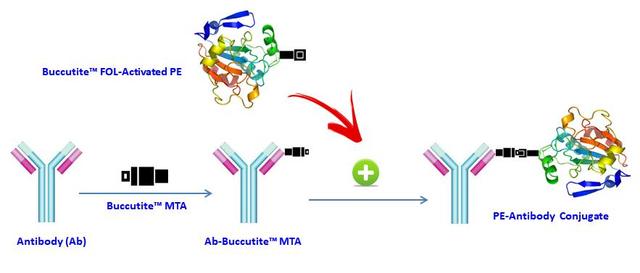Buccutite™ Rapid PE-Cy5.5 Tandem Antibody Labeling Kit *Microscale Optimized for Labeling 25 ug Antibody Per Reaction*
Example protocol
AT A GLANCE
- Add 1.25 µL Reaction Buffer (Component C) into antibody (25 µL)
- Add 2.5 µL Buccutite™ MTA working solution
- Incubate at room temperature for 30 - 60 minutes
- Mix with 50 µL Buccutite™ FOL-Activated PE-Cy5.5 working solution
- Incubate at room temperature for 60 minutes
Upon receipt, store the kit at 4 °C. When stored properly, the kit should be stable for six months. Alternatively Components A and B can be stored at -20 °C. Do not freeze Reaction Buffer (Component C). Warm all the components and centrifuge the vials briefly before opening, and immediately prepare the required solutions before starting your conjugation. The following SOP is an example for labeling goat anti-mouse IgG antibody.
PREPARATION OF WORKING SOLUTION
For labeling 25 µg antibody (assuming the target antibody concentration is 1 mg/mL), mix 1.25 µL (5% of the total reaction volume) of Reaction Buffer (Component C) with 25 µL of the target antibody solution.
Note: If you have a different concentration, adjust the antibody volume accordingly to make ~25 µg antibody available for your labeling reaction.
Note: The antibody should be dissolved in 1X phosphate buffered saline (PBS), pH 7.2-7.4; If the antibody is dissolved in glycine buffer, it must be dialyzed against 1X PBS, pH 7.2-7.4, or use Amicon Ultra-0.5, Ultracel-10 Membrane, 10 kDa ( Cat. # UFC501008 from Millipore) to remove free amines or ammonium salts (such as ammonium sulfate and ammonium acetate) that are widely used for antibody precipitation.
Note: Impure antibodies or antibodies stabilized with bovine serum albumin (BSA) or gelatin will not be labeled well.
Note: The antibody –Buccutite™ MTA reaction efficiency is significantly reduced if the antibody concentration is less than 1 mg/mL. For optimal labeling efficiency the final antibody concentration range of 1-10 mg/mL is recommended.
Add 10 µL DMSO (Not provided) into the vial of Buccutite ™ MTA (Component B).
Add 50 µL ddH2O into the vial of Buccutite ™ FOL-Activated PE-Cy5.5 (Component A).
SAMPLE EXPERIMENTAL PROTOCOL
- Add 2.5 µL of Buccutite ™ MTA working solution into antibody working solution, and mix them well by repeatedly pipetting for a few times or vortex the vial for a few seconds.
Keep the antibody- Buccutite ™ MTA reaction mixture at room temperature for 30 - 60 minutes.
Note: The antibody-Buccutite™ MTA reaction mixture can be rotated or shaken for longer time if desired.
- Add 50 µL of Buccutite™ FOL-Activated PE-Cy5.5 working solution with Antibody-Buccutite™ MTA solution, mix well by repeatedly pipetting for a few times or vortex the vial for a few seconds.
- Incubate for 1 to 2 hours.
The antibody-PE-Cy5.5 conjugate is now ready to use.
Note: For immediate use, the antibody-PE-Cy5.5 conjugate need be diluted with the buffer of your choice.
Note: For longer term storage, antibody-PE-Cy5.5 conjugate solution need be concentrated or freeze dried.
The antibody conjugate should be stored in the presence of a carrier protein (e.g., 0.1% bovine serum albumin) and 0.02-0.05% sodium azide. The Ab-PE-Cy5.5 conjugate solution could be stored at 4 °C for two months without significant change and kept from light.
Table 1. Available fluorophores at AAT Bioquest Buccutite™ Rapid Antibody Labelling Kits
| Cat# | Labels | Ex (nm) | Em (nm) |
| 1312 | PE | 565 | 575 |
| 1340 | PE-Cy5 | 565 | 674 |
| 1341 | PE-Cy5.5 | 565 | 700 |
| 1342 | PE-Cy7 | 565 | 780 |
| 1343 | PE-Texas Red | 565 | 600 |
| 1313 | APC | 651 | 662 |
| 1347 | APC-iFluor® 700 | 651 | 713 |
| 1350 | APC-Cy5.5 | 651 | 700 |
| 1351 | APC-Cy7 | 651 | 780 |
| 1353 | PerCP | 482 | 677 |
1348 | APC-iFluor® 750 | 651 | 791 |
Spectrum
Product family
| Name | Excitation (nm) | Emission (nm) | Extinction coefficient (cm -1 M -1) |
| Buccutite™ Rapid APC-Cy5.5 Tandem Antibody Labeling Kit *Microscale Optimized for Labeling 100 ug Antibody Per Reaction* | 651 | 700 | 700000 |
| Buccutite™ Rapid APC-Cy5.5 Tandem Antibody Labeling Kit *Microscale Optimized for Labeling 25 ug Antibody Per Reaction* | 651 | 700 | 700000 |
| Buccutite™ Rapid APC-Cy5.5 Tandem Antibody Labeling Kit *Production Scale Optimized for Labeling 1 mg Antibody Per Reaction* | 651 | 700 | 700000 |
References
Authors: Zhao KH, Su P, Li J, Tu JM, Zhou M, Bubenzer C, Scheer H.
Journal: J Biol Chem (2006): 8573
Authors: Petrasek Z, Schmitt FJ, Theiss C, Huyer J, Chen M, Larkum A, Eichler HJ, Kemnitz K, Eckert HJ.
Journal: Photochem Photobiol Sci (2005): 1016
Authors: Loos D, Cotlet M, De Schryver F, Habuchi S, Hofkens J.
Journal: Biophys J (2004): 2598
Authors: Prasanna R, Dhar DW, Dominic TK, Tiwari ON, Singh PK.
Journal: Acta Biol Hung (2003): 113
Authors: Prasanna R, Prasanna BM, Mohammadi SA, Singh PK.
Journal: Folia Microbiol (Praha) (2003): 59



